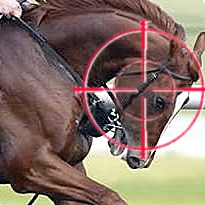 Horseracing bettors in Montana will be muttering into their mint juleps on Saturday as the 138th Kentucky Derby gets underway at Churchill Downs. Shocked by a loss of money at its off-track betting sites, the Montana Board of Horse Racing suspended simulcast operations in December. The suspension was supposed to last two months, but now they’re just hoping to resurrect the simulcasts before the Preakness rolls around later this month.
Horseracing bettors in Montana will be muttering into their mint juleps on Saturday as the 138th Kentucky Derby gets underway at Churchill Downs. Shocked by a loss of money at its off-track betting sites, the Montana Board of Horse Racing suspended simulcast operations in December. The suspension was supposed to last two months, but now they’re just hoping to resurrect the simulcasts before the Preakness rolls around later this month.
No such issues for bettors at Churchill Downs, where the betting handle is expected to top $100m on Saturday. Even better, at the appointed hour, an estimated 15m people across the nation will suddenly pretend to give a shit about horseracing. They’ll mix up a jug of juleps (or bourbon and Mountain Dew, whatever’s on hand) and plunk themselves down in front of their TVs to watch “the fastest two minutes in sports” (which is sorta how I recall losing my virginity). Once those 120 seconds have expired, most of these viewers will switch back to TMZ and forget about racing for another year. But for that one brief shining moment, racing will have America’s attention. And in that moment, everyone connected to this struggling sport will be praying: “Please God, don’t let one of those horses break a leg.”
BLOOD ON THE TRACKS
If being saddled (pardon the pun) with a now unworkable business model wasn’t bad enough, US horseracing is being trampled under a stampede of bad press. In March, the New York Times estimated over 3,000 horse fatalities occurred at US racetracks between 2009-2011. At one track in New Mexico, nine horses died in 13 days. In March of this year, HBO chose to take a $35m loss by shutting down production on its horseracing drama Luck after the deaths of three horses during filming prompted numerous editorials wondering why animals were being killed for our viewing pleasure.
The Times’ analysis of some 150,000 races between 2009-2011 showed an animal breakdown rate of 5.2 per 1,000 starts in the US. Across the border in Ontario, the Woodbine Racetrack has an incident rate of 1.4, which Woodbine VP Jamie Martin attributes to the fact that “medication is not as permissive as it is in the US.” Across the US, the rate of accidents from the lower tier ‘claiming races’ is 22% higher than in the marquee events, which the head of New York State’s testing lab suggested was due in part to some trainers’ willingness to treat their stables as “pharmacist shops,” pumping their cheaper horses full of painkillers, steroids, stimulants, snake venom and Viagra (again, sorta like how I recall losing my virginity). But it seems the most harmful injection of all may be liquid cash.
HORSE SENSE
There’s no question racing is headed for some kind of fundamental restructuring. Parallels with the railway industry’s slow fade to irrelevance after air travel became commonplace are easy to make. Racing is no longer the only game in town, and even significant legislative intervention appears capable only of slowing racing’s inexorable decline. It’s conceivable that racing’s future will involve the closure of a great many regional tracks, with the top equine talent funneled into ‘premier league’ operations left to serve the betting needs of the dwindling faithful.
In the meantime, racetracks are desperate to add other forms of gambling to their offering. Tracks even threaten to use their ties with state politicians to block passage of gambling expansion bills if the tracks aren’t due for a slice of the pie. But the Times’ read of the race data suggests the fatter purses created by these racetrack slots and gaming tables are actually contributing to the number of dead horses. So-called ‘racinos’ can offer purses on claiming races that vastly exceed the value of the participating horses, and even the last place horse receives $1k for giving it the old college try. All of which provides incentives for owners to attempt to squeeze one more race out of an aging or injured animal. If it wins, wonderful. If it dies, no great loss. At least, not for the owner. For the sport, the impact is potentially catastrophic.
Jason Wilson, biz-dev VP at US thoroughbred horse authority the Jockey Club, told Louisville Public Media that racing loses about four percent of its fan base every year. Even among racing’s core fans, only 46% said they would recommend the sport to another person. Meanwhile, long before this recent bout of bad press, polls suggested as many as 38% of Americans support banning racing altogether. With racing’s base eroding, the sport can’t afford that last statistic to rise much higher. So please, God, don’t let one of those Derby horses break a leg rounding the final turn.





